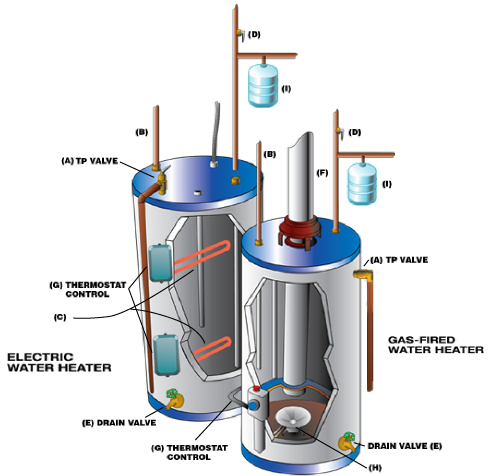Water heaters are one of those appliances that people don’t give much thought, unless they are buying a home or it breaks. But you can know what to look for and evaluate how your water heater is doing. You can even increase its life expectancy with one maintenance tip!
Two Main Types
Electric and gas-fired water heaters with 40 or 50 gallon tanks are the most common for homes and typically last 8 to 12 years. All water heaters with tanks keep the water heated to a preset temperature that you can adjust for comfort. As hot water is used, it draws fresh water into the tank and heats it for the next time. It is ready 24/7 whether people are home or not. Because there is a lot of pressure and heat within a tank, there is an emergency relief valve either on the top or within 6 inches of the top of the tank. This Temperature and Pressure (T & P) valve is normally plumbed to expel hot water outdoors within 6 inches to the ground to avoid scalding anyone. There will also be a drain valve near the bottom of the tank. This can be used to drain the tank for repair, replacement, or maintenance. If the tank is installed in an area that can damage the house, a metal drip pan is required underneath. The pan will also need to be plumbed to expel outside. Contact a licensed professional plumber for installing new equipment.
- Gas-fired Heater Specialties
Gas water heaters are more complicated since gas and fire are being used to heat the water. They will have the incoming and outgoing pipes on the top, the T & P valve, drain valve, and most likely a drip pan. There will also be an incoming gas line that needs a drip leg (or sediment trap) to prevent moisture or sediment from entering the appliance. It will have a protected burner area and an opening on top to exhaust dangerous gas by-products from the tank and house. A draft hood sits slightly above the hole at the top of the tank. It connects to a smooth metal B-vent and takes the hot gases safely out of the house. At a ceiling or wall, it should have a collar that keeps any combustible products away from the vent. If the tank is stored in the garage, an18 inch stand protects the tank from physical damage and prevents flammable fumes or liquids catching on fire.
Check It Out
The first step in evaluating your water heater would be to check the label for when it was made. That gives you a good starting point.
- Rust or Crust
Do you see any rust on the tank? Is there corrosion on the water lines? Does the pan have water or any rust? Does the T & P valve show signs of corrosion or leaking? Once a water heater starts to leak, it needs to be replaced because it won’t get better.
- Connectivity
Is the draft hood positioned over the exhaust hole? People often forget to reattach it after replacing a water heater. Is the vent attached to the draft hood? Sometimes these are knocked off accidentally. Is there a piece of round metal hanging down around the vent and not on the ceiling? That would be the collar, and it should be protecting the space at ceilings or walls.
Rusty Water?
Drain all the water out of the tank once or twice a year every year. It will allow sediment and minerals that build up inside the tank to be flushed out of the system. If you have two tanks, be sure to drain both. Otherwise, over time the sediment will build up and your faucets will spit out dirty, rust colored water from the bottom of the tank. Be sure to turn off an electric or shut off the gas before draining the tank if using the drain valve. The easiest method is to run all the water out through your shower or tub faucets.
We inspected a home with a twenty year old water heater that had been flushed every six months. It appeared to be in great shape, producing hot water without any issues! The most amazing fact is that this was well water, and the tank for the well also was functioning great. Ladies and gentlemen, start flushing!

